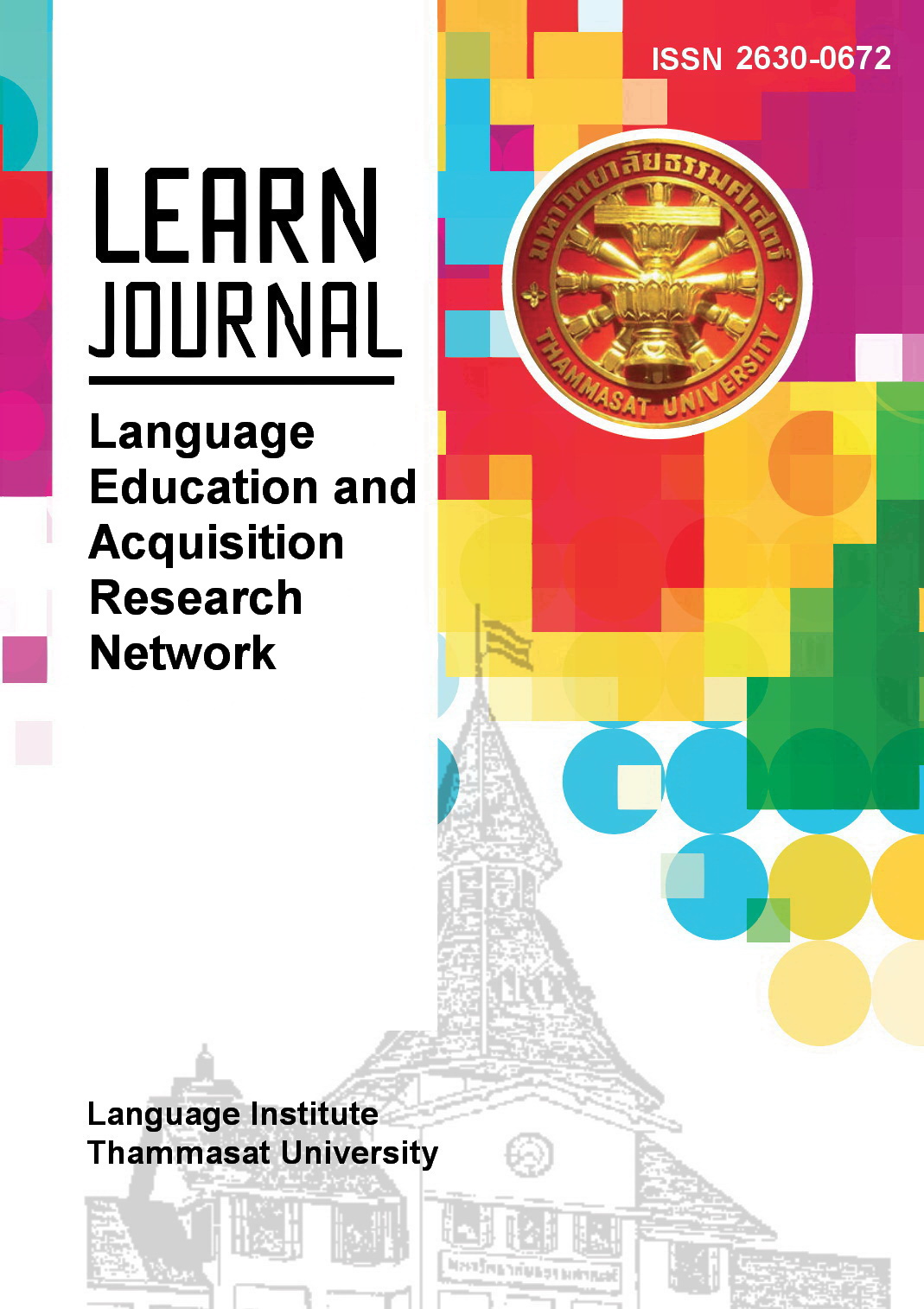A Study of Move Analysis in American NPOs' Online Fundraising Pages: A Comparison between Domestic and Global Campaigns in Health Operations
Main Article Content
Abstract
This study examines the language used in the campaign descriptions (CDs) posted by nonprofit organizations (NPOs) through www.globalgiving.org, an international fundraising platform for nonprofits around the world. The purpose of this study aims to identify the similarities and differences among those that occurred in the campaign descriptions of domestic and global campaigns under the theme of health operations. One condition is that each NPO has to write a campaign description following the template provided by the website, which contains four different sections: ‘Summary’, ‘Challenge’, ‘Solutions’, and ‘Long-term Impact’. A move analysis on 158 CDs found six moves and 15 steps used across the descriptions in both corpora. The results suggested that ‘Identifying the Locations of the Problem’ was an essential move for the global campaigns, while this move was not necessary to be included in the domestic campaigns. The common rhetorical moves found in this study can help other NPOs that are planning on putting their campaigns online by writing their descriptions in English. The results will benefit nonprofits around the world. Language learners and professionals can also learn the persuasive writing style of fundraising discourses in this study.
Article Details
References
Abelen, E., Redeker, G., & Thompson, S. A. (1993). The rhetorical
structure of US-American and Dutch fund-raising letters. Text - Interdisciplinary Journal for the Study of Discourse, 13(3), 323-350. https://doi.org/10.1515/text.1.1993.13.3.323
Askehave, I., & Swales, J. M. (2001). Genre identification and
communicative purpose: A problem and a possible solution. Applied Linguistics, 22(2), 195-212. https://doi.org/10.1093/applin/22.2.195
Azhar, I. (2015). Philanthropy language construction. International
Journal of Humanities and Cultural Studies, 2(2), 119–129. http://ijhcschiefeditor.wix.com/ijhcs
Barman, E. (2017). The social bases of Philanthropy. Annual Review of
Sociology, 43(1), 271–290. https://doi.org/10.1146/annurev-soc-
-053524
Becker, P. (1974). A theory of social interactions. National Bureau of
Economic Research.
Berkenkotter, C., & Huckin, T. N. (1994). Genre knowledge in disciplinary
communication: Cognition/culture/power. Routledge.
Berzlánovich, I., & Redeker, G. (2012). Genre-dependent interaction of
coherence and lexical cohesion in written discourse. Corpus Linguistics and Linguistic Theory, 8(1), 183–208. https://doi.org/10.1515/cllt-2012-0008
Bhatia, V. K. (1993). Analysing genre: Language use in professional
settings. Routledge.
Bhatia, V. K. (1998). Generic patterns in fundraising discourse. New
Directions for Philanthropic Fundraising, 1998(22), 95–110.
https://doi.org/10.1002/pf.2207
Bhatia, V. K. (2002). Applied genre analysis: A multi-perspective model.
Ibérica: Revista de La Asociación Europea de Lenguas Para Fines Específicos (AELFE), 4, 3–19.
Bhatia, V. K. (2004). Worlds of written discourse: A genre-based view.
Bloomsbury Publishing.
Bhatia, V. K. (2012). Critical reflections on genre analysis. Ibérica: Revista
de La Asociación Europea de Lenguas Para Fines Específicos (AELFE), 24, 17–28.
Biel, Ł. (2017). Genre analysis and translation. In K. Malmkjœr (Ed.), The
Routledge handbook of translation studies and linguistics (pp. 151–164). Routledge. https://doi.org/10.4324/9781315692845-11
Browning, B. (2012). Perfect phrases for fundraising. McGraw-Hill
Education.
Burke, K. (1945). A grammar of motives, semantics with a difference.
Prentice Hall.
Connor, U., & Mauranen, A. (1999). Linguistic analysis of grant proposals:
European Union Research Grants. English for Specific Purposes,
(1), 47–62. https://doi.org/10.1016/s0889-4906(97)00026-4
Cotos, E. (2019). Articulating societal benefits in grant proposals: Move
analysis of Broader Impacts. English for Specific Purposes, 54, 15–34. https://doi.org/10.1016/j.esp.2018.11.002
Flowerdew, L. (2000). Using a genre-based framework to teach
organizational structure in academic writing. ELT Journal, 54(4), 369–378. https://doi.org/10.1093/elt/54.4.369
Fusari, S. (2009). Philanthropic direct mail in an English/ Italian
perspective: A corpus-based study. Facta Universitatis, 7(2), 149–161. https://www.ceeol.com/search/article-detail?id=268223
Gautier, A., & Pache, A. C. (2013). Research on corporate philanthropy: A
review and assessment. Journal of Business Ethics, 126(3), 343-369.
Goering, E., Connor, U. M., Nagelhout, E., & Steinberg, R. (2009).
Persuasion in fundraising letters: An interdisciplinary study. Nonprofit and Voluntary Sector Quarterly, 40(2), 228–246. https://doi.org/10.1177/0899764009339216
Kanoksilapatham, B. (2005). Rhetorical structure of biochemistry
research articles. English for Specific Purposes, 24(3), 269–292. https://doi.org/10.1016/j.esp.2004.08.003
Kitova, Y. (2014). Discourse and linguistic features in appeal letters.
Academia.edu.
Lainer-Vos, D. (2014). Brothers’ keepers: Gift giving networks and the
organization of Jewish American diaspora nationalism. Socio-Economic Review, 12(3), 463–488. https://doi.org/10.1093/ser/mwu003
Lee, P. C.-W. (2016). A discourse description of four fundraising texts –
linguists meet practitioners: An exploratory study. Discourse and Interaction, 9(2), 25–50. https://doi.org/10.5817/di2016-2-25
Longacre, R. E. (1992). The discourse strategy of an appeals letter. In
W.C. Mann & S.A. Thompson (Eds.), Discourse description: Diverse linguistic analyses of a fund-raising text (pp. 109–130). John Benjamins. https://doi.org/10.1075/pbns.16.06lon
Martin, J. (2017). Move analysis and the philanthropic letter. ERA:
Education and Research Archive. University of Alberta Libraries.
https://doi.org/10.7939/R3BK17389
Musick, M. A., & Wilson, J. (2007). Volunteers. Amsterdam University
Press.
Ritzenhein, D. N. (1998). Content analysis of fundraising letters. New
Directions for Philanthropic Fundraising, 1998(22), 23–36. https://doi.org/10.1002/pf.2202
Sadeghi, V., & Samuel, M. (2013). Genre analysis of the letters of appeal.
Discourse Studies, 15(2), 229–245. https://doi.org/10.1177/1461445612471467
Sandouka, K. (2019). Text analysis of crowdfunding: A literature review.
Proceedings of the Americas Conference on Information Systems (AMCIS), 1–5.
Swales, J. (1990). Genre analysis: English in academic and research
settings. Cambridge University Press.
Swales, J. M. (2000). Languages for specific purposes. Annual Review of
Applied Linguistics, 20, 59–76. https://doi.org/10.1017/s0267190500200044
Thumvichit, A. (2017). A comparative genre analysis of Thai and UK
hotels’ responses to complaints on TripAdvisor [Doctoral dissertation, Thammasat University]. Thammasat University Library. https://doi.org/10.14457/TU.the.2017.745
Turner, R. H., & Homans, G. C. (1961). Social behavior: Its elementary
forms. American Sociological Review, 26(4), 635-636. https://doi.org/10.2307/2090265
Upton, T. A. (2002). Understanding direct mail letters as a genre.
International Journal of Corpus Linguistics, 7(1), 65–85. https://doi.org/10.1075/ijcl.7.1.04upt
Upton, T. A., & Cohen, M. A. (2009). An approach to corpus-based
discourse analysis: The move analysis as example. Discourse Studies, 11(5), 585–605. https://doi.org/10.1177/1461445609341006
Wei, J., & Gampper, C. (2014). A corpus-based collocation study and
move patterns in online smartphone press releases. LEARN
Journal: Language Education and Acquisition Research Network, 7(2), 99–110.
Zhou, M., Lu, B., Fan, W., & Wang, G. A. (2016). Project description and
crowdfunding success: An exploratory study. Information Systems
Frontiers, 20(2), 259–274. https://doi.org/10.1007/s10796-016-
-1


